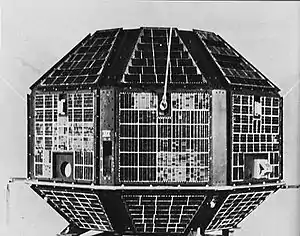| Names | CartoSat-2A | ||||
|---|---|---|---|---|---|
| Mission type | Earth observation | ||||
| Operator | NTRO | ||||
| COSPAR ID | 2008-021A | ||||
| SATCAT no. | 32783 | ||||
| Website | https://www.isro.gov.in/ | ||||
| Mission duration | 5 years (planned) 15 years, 8 months and 19 days (in progress) | ||||
| Spacecraft properties | |||||
| Spacecraft | Cartosat-2a | ||||
| Bus | IRS-2[1] | ||||
| Manufacturer | ISRO | ||||
| Launch mass | 690 kg (1,520 lb) [2][3] | ||||
| Dry mass | 626 kg (1,380 lb) [3] | ||||
| Power | 900 watts[2][3] | ||||
| Start of mission | |||||
| Launch date | 28 April 2008, 03:54:00 UTC[4] | ||||
| Rocket | Polar Satellite Launch Vehicle (PSLC-C9) [5] | ||||
| Launch site | Satish Dhawan Space Centre, SLP[5] | ||||
| Contractor | ISRO | ||||
| Orbital parameters | |||||
| Reference system | Geocentric orbit | ||||
| Regime | Sun-synchronous orbit | ||||
| Perigee altitude | 616 km (383 mi) | ||||
| Apogee altitude | 637 km (396 mi) | ||||
| Inclination | 98.0° | ||||
| Period | 97.3 minutes | ||||
| |||||
Cartosat-2A is an Earth observation satellite in a Sun-synchronous orbit and the third of the Cartosat series of satellites. The satellite is the thirteenth satellite in the Indian Remote Sensing (IRS) satellite series to be built, launched by the Indian Space Research Organisation.
Launch
It was launched by the Polar Satellite Launch Vehicle (PSLV-C9) on 28 April 2008, «t 03:54:00 UTC, along with the 87 kg Indian Mini Satellite (IMS-1) and eight nano research satellites belonging to research facilities. The CanX-2 and the CanX-6 of Canada, the AAUSAT-2 of Denmark, the Compass-1 and the Rubin-8 of Germany, the CUTE-1.7 of Japan, and the Delfi-C3 of the Netherlands.[6]
IMS-1 satellite
The IMS-1 satellite is a Ministry of Defence mission for the Government of India.[7] It is a dedicated satellite for the Indian Armed Forces (IAF) which is in the process of establishing an Aerospace Command.[8]
Payload
The satellite carries a panchromatic (PAN) camera capable of taking black-and-white pictures in the visible region of electromagnetic spectrum. The highly agile Cartosat-2A can be steered up to 45° along as well as across the direction of its movement to facilitate imaging of any area more frequently. The satellite's health is continuously monitored from the Spacecraft Control Centre at Bangalore with the help of ISRO Telemetry, Tracking and Command Network (ISTRAC) of stations at Bangalore, Lucknow, Mauritius, Bearslake in Russia, Biak in Indonesia and Svalbard in Norway.[9]
See also
References
- ↑ "Cartosat 2, 2A, 2B, 2C, 2D, 2E". Gunter's Space Page. Retrieved 19 June 2017.
- 1 2 "Cartosat-2A". ISRO. 28 April 2008. Archived from the original on 10 June 2017. Retrieved 19 June 2017.
- 1 2 3 "Satellite: CartoSat-2A". World Meteorological Organization. Retrieved 19 June 2017.
- ↑ "Display: Cartosat 2A 2008-021A". NASA. 27 April 2021. Retrieved 10 May 2021.
 This article incorporates text from this source, which is in the public domain.
This article incorporates text from this source, which is in the public domain. - 1 2 "PSLV C9/Cartosat 2A/IMS-1 Mission Brochure" (PDF). Indian Space Research Organisation. Archived from the original (PDF) on 31 July 2017. Retrieved 19 June 2017.
- ↑ India in multi-satellite launch
- ↑ "ISRO arm may get more satellite launch contracts, by K. Pichumani". Archived from the original on 11 September 2009. Retrieved 15 April 2008.
- ↑ "India to launch first military satellite in August". 10 June 2008. Archived from the original on 2 May 2008. Retrieved 18 July 2010.
- ↑ PSLV Successfully Launches Ten Satellites Archived 1 May 2008 at the Wayback Machine
External links
- Cartosat-2A website Archived 10 June 2017 at the Wayback Machine

